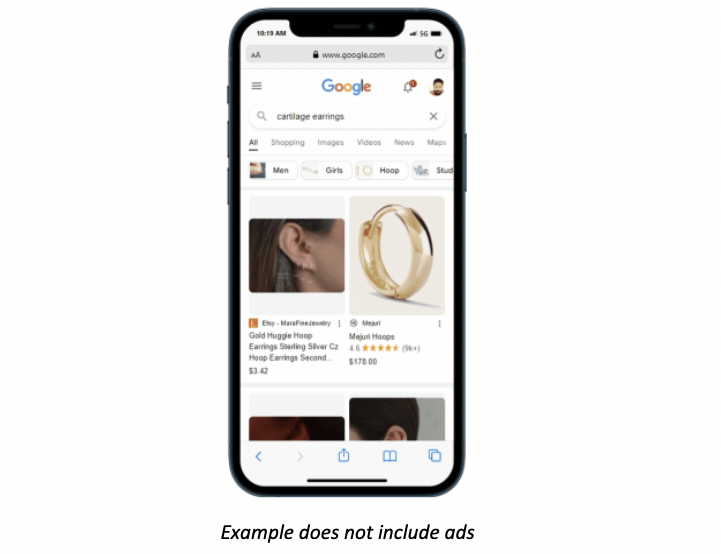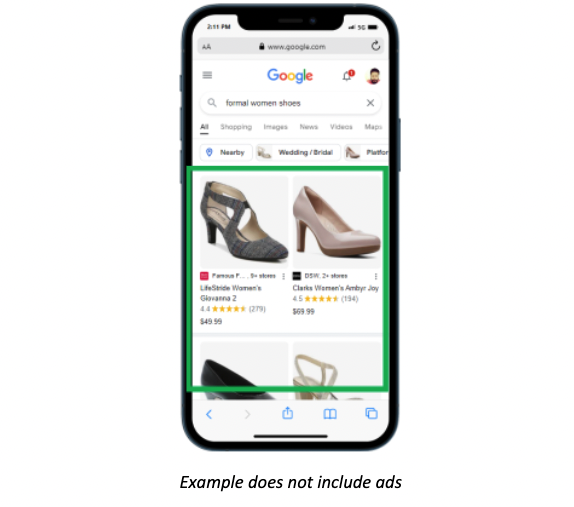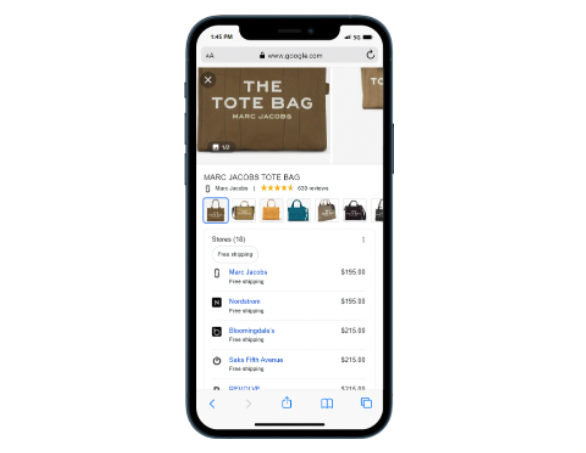
Boost your rankings and attract more customers through our SEO expertise.

In my short, eight-year career in SEO, I have seen many algorithm and search changes that have had an impact on overall rankings and experience within Google. Within the past year or so, Google has made several changes to its search engine results pages (SERPs), but none more interesting or impactful than the introduction of their Search On initiative. At its core, it is meant to help users by creating richer search experiences with the help of AI, but at times it feels like nothing more than a way for Google to reposition itself once again in the ever-expanding search space. (It is worth noting this is only happening within US mobile experiences and we have yet to see these features in other major markets like Canada and the UK.)
There are many parts to the Search On initiative, but for this article I really want to focus on the Search On shopping initiative. Google refers to the shopping experience change as a way to help connect shoppers with the right products for them, while helping millions of merchants and brands get discovered on Google. Although there does seem to be a level of upgraded UX considerations, we feel like this is more so Google’s answer in the ecommerce space to offset the likes of Amazon and other large e-retailers eating away at their search market share. We also see it as a way for them to continue to innovate and drive revenue from advertising.
From my view, this change has had a bigger impact on my ecommerce clients than any other traditional algorithm or SERP feature change in recent years. Obviously there have been bigger updates and algorithm shakeups, but in terms of what to expect from changes and the actual impact it will have or is having on SEO, there has been little information on the Search On shopping update to date. Add in current economical context and the fact that this initiative rolled out at the tail end of COVID-19, there is a lot we need to unpack when it comes to the changing landscape of ecommerce SEO within Google.
Google touts the Search On shopping experience as a way to “window shop right from search”. When you look at the new functionality, it does look and feel like a better way to navigate SERPs for ecommerce purposes.

On closer inspection, however, you really get a better understanding of what Google is trying to accomplish, which feels more like an expansion of its owned real estate within SERPs—all while increasing businesses’ dependence on Google products. There are four new features that are having an overall impact on how ecommerce sites are positioned organically within the updated SERPs, all of which are having a larger-than-usual impact on traffic for some of our ecommerce clients compared to other recent updates like Product Listing Ads (PLAs).
By far one of the most overlooked features of Google’s new shopping design is the filtered carousel. This is something that I believe is better overall for the search experience but will also have the largest impact on traditional SEO methodologies.
From the example above, we can see how a primary term like “shoes”, which has around 1.2M searches a month, can be changed to a sub-themed search, with far less search volume, instantly with the use of a filter. With the new SERP you now have X number of new results and a SERP format more specific to the new query. While helpful, this feature also creates additional ad space for more holistic content. This allows Google to more easily “help millions of merchants and brands get discovered on Google”, organically or otherwise.
If you were to do a competitive analysis within your specific vertical, you would find that larger e-retailers like Amazon, Etsy, and Nordstrom are benefiting the most from this change organically. My hypothesis is that those retailers have more experience in the ecommerce space and have had systems in place for a while now to handle dynamic feature pages that are SEO-friendly, more so than newer ecommerce brands.
From our initial analysis of the faceting feature within shopping experiences, main or top-level pages that previously ranked for long-tail terms have seen significant decrease in traffic YoY. Meanwhile, pages where our clients have expanded categories and features have seen traffic shift towards those pages from terms more aligned to the specific feature. There is a direct correlation to performance and sub-category coverage that show both positive and negative impacts of this change.
We don’t want to get too far into the weeds from a tactical standpoint, but something else e-retailers need to consider is how to scale this feature/sub-category content. This is typically a harder task to solve for smaller e-retailers as it not only involves understanding content opportunities for highly searched sub-categories, but it is also dependent on technology. Optimising this type of content is largely dependent on CMS, PIM systems (Product Inventory Management), and other apps or plugins that most teams outside of development have little knowledge of. Additionally, most ecommerce sites already have well-established tech stacks. If optimising for this is not feasible, it may require reconsideration of technology or a more manual solution, both of which require major bandwidth.
Lastly, with the new facet carousel, the overall impact from more granular facets and different SERP types has a direct impact on expected traffic and dilutes volume for keywords to top-level pages. You should start to see those shifts soon if you haven’t already.
With the rise of the facet functionality and new SERP types, there has been a significant increase in free product listings results. It’s hard to ignore just how prominent free product listings are today in the organic search experience.

Below you can find archived SERPs from STAT Search Analytics for the same keyword one year apart, from May of last year to now:

We can see that Google’s organic presence in ownership of those positions has significantly increased YoY, leaving limited real estate for other retailers and brands. We have compared this to Google Search Console (GSC) and have seen significant click decreases while average positions have barely moved. Additionally, it is important to note these listings are largely dependent on feeds which are managed within Google Merchant Center. To get “free listings”, you must opt in within the merchant center. This results in retailers and brands becoming more dependent on Google for ecommerce success.
Subscribe to our monthly newsletter.
First, free listings make retailers and brands more dependent on Google for ecommerce success as they need to have GMC setup. The new organic product experience for brands is robust and in-depth. This will require brands to put more effort and resources into ensuring their feeds are accurate as well as paying closer attention to seasonal promotions to account for increased competition from pricing and shipping cost.
Secondly, the fact that users are now more likely to start coming in through Product Description Pages (PDPs) makes it more important than ever to understand the overall impact those organic experiences have on conversion rate. These landing page types and how users get to those pages becomes extremely important as SEO conversion becomes more dependent on what the experience is after the initial landing page. Experience and expectation can differ significantly for someone coming in on a PDP vs. a Product Listings Page (PLP) and a non-brand vs. branded term. This requires a better understanding of UX and IA across the entire ecommerce site experience for multiple different page types.
Early indicators have shown us that some PDP experiences are not UX-optimised for users navigating sites after the initial PDP entry. This has resulted in conversion rate decline for the PDP page type and additional revenue loss from the traffic shifts.

Brands that sell on large retailers must reconsider how they position themselves against those same retailers in the digital space. This impacts everything, including organic cannibalisation from branded traffic by larger retailers as well as the increase of branded CPCs due to added competition for branded terms. Quick note: The product comparison features in free listings has greatly increased for non-brand terms as well.
Another major update from the Search On initiative has been the importance of inventory at the local level. The Search On shopping announcement spoke to the push to allow users to shop in-store inventory within the local pack. That feature is also specifically tied to Google Merchant Center, which expands brands dependence on Google as it again makes retailers rely on them more for local organic presence.
Google officially updated language within their Business Profile Help Center that states adding in-store products can help with local visibility. We are also starting to see less traditional SERP features roll out/being tested that show locations related to specific inventory for category listings or PLP pages.
During the past Q4 holiday season, we also saw significant increases in non-brand visits without local qualifiers to local landing pages across a host of clients.

With local presence becoming much more dependent on inventory and GMC feeds, it’s important we allocate the appropriate resources to help manage those feeds.
Additionally, like the free listings example, with more users coming in through the local pages from non-branded and non-local terms, it’s important that SEOs assess what the local landing page experience looks and feels like to better optimise the user experience.
Around the same time Google announced Search on 21′, it also announced the update for continuous scrolling within mobile experiences. Google states that users want to view more content within a SERP, and it was not uncommon for users looking for more information to browse up to four pages of search results.
This is a straightforward approach for Google to help create better UX while also increasing visibility of brands not able to get that first page visibility. The experience does feel more seamless, and we do like it better.
All praise aside, this feature paired with the other callouts in the previous section is slowly causing reporting difficulties for our brands concerned about CTR, impressions, and positioning. The ease of browsing deeper pages aligned with richer ecommerce SERP experiences means that top position does not always translate to %X of expected clicks. This is something we have always been privy to, but it is worth noting that this could have additional impact on reporting and forecasting moving forward.
Anyone reading this in the ecommerce space will likely feel the impact from the updates listed above. Although I have called out these changes as being self-serving for Google at times, by no means do I think this is bad for Google or its users. In my professional opinion, some of these changes are great, like infinite scroll for example. But I’m not so keen on other changes, like sending users to free listing PDP pages for top-of-funnel search queries. At the end of the day though, that is not really for me to argue. Chances are I will not fare well against AI and machine learning.
As Google continues to innovate within the search space, we as marketers and SEOs must continue to grow and adapt with it. However big or small these innovations are, we need to approach every change—whether it’s directly tied to SEO or not—with a level of critical thinking to ask ourselves three questions:
By answering these questions, we can continue to tackle each new challenge and make the right decisions for our clients.
Subscribe to our monthly newsletter.